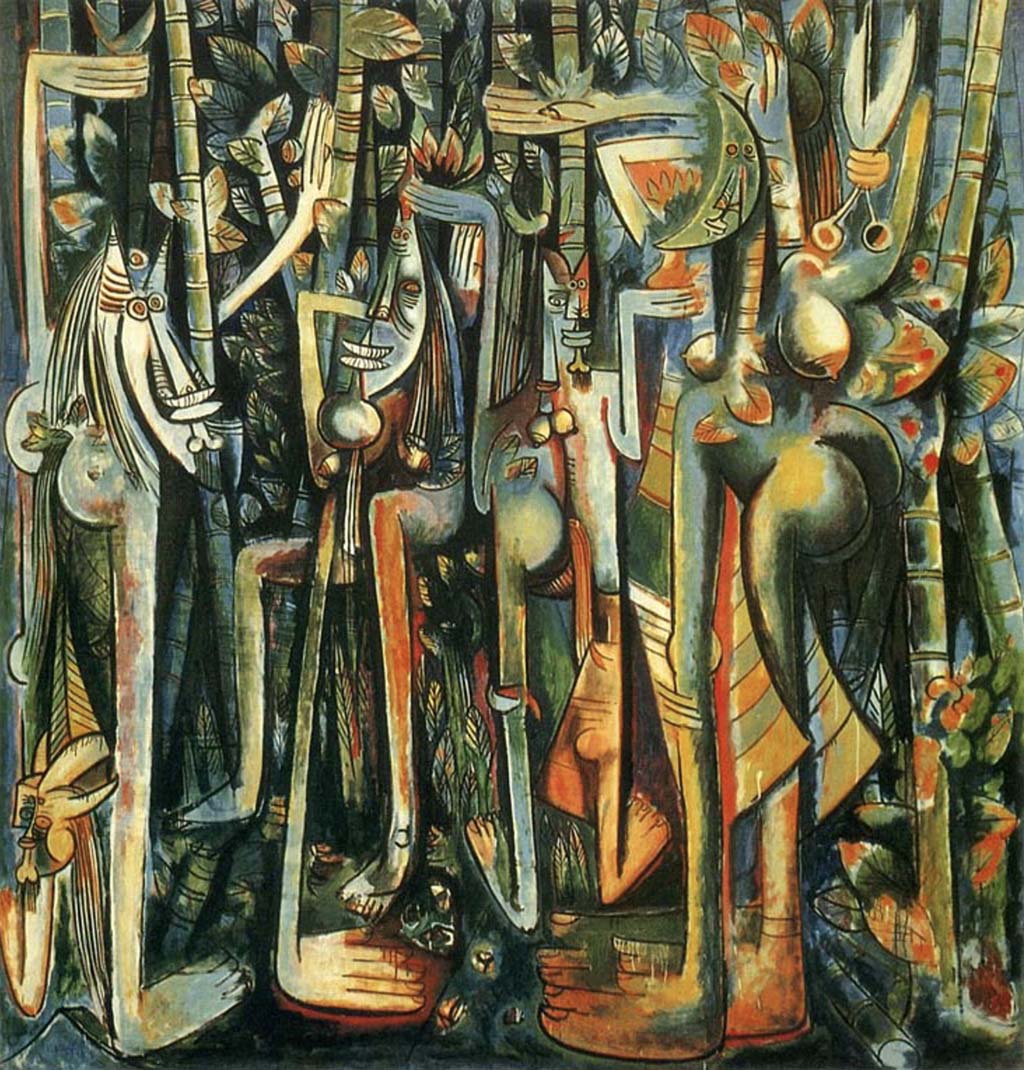Harlem Renaissance Negritude Movement and Black Arts Movement and Creolite Have Shaped

The Jungla (Wilfredo Lam, 1943)
Off-white Utilise historical paradigm
The literary movement, Negritude, was born out of the Paris intellectual surround of 1930s and 1940s. It is a production of black writers joining together through the French language to assert their cultural identity.
Aimé Césaire was the beginning to money the word in his epic verse form, Cahier d'un retour au pays natal, declaring "my negritude is not a stone, its deafness hurled against the bedlam of the mean solar day" simply instead, his negritude "takes root in the agog flesh of the soil." Together with Césaire, Léon Damas and Léopold Sédar Senghor created poesy that would brand a definition for Negritude. The best-known Negritude works from these poets were Damas' Pigments, Senghor's Hosties noire and Chants d'ombre, and Césaire'southward Cahier. These poets were brought together in the cosmos of the journal, L'Etudiant noire.
50'Etudiant noire responded to similar black journals in Paris at the fourth dimension. Césaire and Senghor idea the West-Indian journal, Légitime défense, was too assimilationist and they institute the Nardal sisters' journal, Revue du monde noir, too bourgeois to truly represent the French-speaking blackness experience. Despite existence a carve up tract from these journals, L'Etudiant noire would not have been possible if the Nardal sisters and Légitime défense hadn't created an environment in Paris for black intellectualism.
The Harlem Renaissance inspired Negritude. Authors such every bit Claude McKay and Langston Hughes laid groundwork for black expression. Senghor, Damas and Césaire together drew influence from their piece of work. Other artistic influences were jazz and earlier fin-de-siècle poets such as Rimbaud, Mallarmé and Baudelaire.
Negritude responded to the alienated position of blacks in history. The motion asserted an identity for black people effectually the world that was their own. For Césaire and Damas, from Martinique and French Guiana, the rupture from Africa through the Atlantic Slave Trade was a dandy part of their cultural understanding. Their piece of work told of the frustration and loss of their motherland. For Senegalese Senghor, his works focused more on African traditionalism. In ways the assertion of each poet diverges from each other, only the combination of unlike perspectives is also what fueled and fed Negritude.
From a political standpoint, Negritude was an important aspect to the rejection of colonialism. Emerging at the cusp of African independence movements, Negritude made an touch on how the colonized viewed themselves. It also sparked and fed off of subsequent literary movements that were responding to global politics. Aimé Césaire and his married woman, Suzanne, would become prominent Caribbean Surrealist writers, respected by the Surrealist leader, Andre Breton. I of Senghor's books, Anthologie de la nouvelle poésie négre et malgache, included an introduction past existentialist author, Jean-Paul Sartre. Sartre'due south introduction, Orphée Noir (Black Orpheus), discussed Negritude as the "anti-racist racism."
There is no clear terminate engagement to the movement, and some literary critics say that information technology still continues today, in any artistic expression asserting black identity.
Exercise you detect this information helpful? A small donation would assist us keep this available to all. Forego a bottle of soda and donate its cost to us for the data y'all just learned, and feel good about helping to make it bachelor to everyone.
BlackPast.org is a 501(c)(3) not-profit and our EIN is 26-1625373. Your donation is fully revenue enhancement-deductible.
Cite this article in APA format:
Micklin, A. (2008, June 29). Negritude Motility. BlackPast.org. https://www.blackpast.org/global-african-history/negritude-move/
Source of the author'southward information:
Clayton Eshleman and Annette Smith, Aimé Césaire: Collected Verse, Trans. past Eshleman and Smith (Berkeley: Academy of California Press, 1983); Lilyan Kesteloot, Blackness Writers in French: A Literary History of Negritude, Trans. by Ellen Conroy Kennedy (Washington D.C.: Howard University Press, 1991).
Source: https://www.blackpast.org/global-african-history/negritude-movement/
0 Response to "Harlem Renaissance Negritude Movement and Black Arts Movement and Creolite Have Shaped"
Postar um comentário